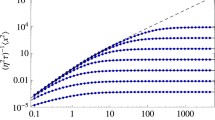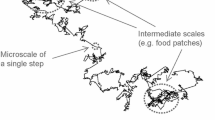Abstract
Be \(X_t\) a random walk. We study its span S, i.e. the size of the domain visited up to time t. We want to know the probability that S reaches 1 for the first time, as well as the density of the span given t. Analytical results are presented, and checked against numerical simulations. We then generalize this to include drift, and one or two reflecting boundaries. We also derive the joint probability of the maximum and minimum of a process. Our results are based on the diffusion propagator with reflecting or absorbing boundaries, for which a set of useful formulas is derived.







Similar content being viewed by others
References
Feller, W.: Introduction to Probability Theory and Its Applications. Wiley, New York (1950)
Redner, S.: A Guide to First-Passage Problems. Cambridge University Press, Cambridge (2001)
Borodin, A.N., Salminen, P.: Handbook of Brownian Motion—Facts and Formulae. Birkhäuser, Boston (2002)
Weiss, G.H., DiMarzio, E.A., Gaylord, R.J.: First passage time densities for random walk spans. J. Stat. Phys. 42, 567–572 (1986)
Palleschi, V., Torquati, M.R.: Mean first-passage time for random-walk span: comparison between theory and numerical experiment. Phys. Rev. A 40, 4685–4689 (1989)
Daniels, H.E.: The probability distribution of the extent of a random chain. Math. Proc. Camb. Philos. Soc. 37, 244–251 (1941)
Feller, W.: The asymptotic distribution of the range of sums of independent random variables. Ann. Math. Stat. 22, 427–432 (1951)
Weiss, G.H., Rubin, R.J.: The theory of ordered spans of unrestricted random walks. J. Stat. Phys. 14, 333–350 (1976)
Annesi, B., Marinari, E., Oshanin, G.: Covariance of the running range of a Brownian trajectory, (2019), arXiv:1902.06963
Rager, C.L., Bhat, U., Bénichou, O., Redner, S.: The advantage of foraging myopically. J. Stat. Mech. 2018, 073501 (2018)
Cannon, J.R.: The One-Dimensional Heat Equation. Encyclopedia of Mathematics and Its Applications, vol. 23. Department of Mathematics, MIT, Cambridge (1984)
Bray, A.J., Smith, R.: Survival probability of a diffusing particle constrained by two moving, absorbing boundaries. J. Phys. A 40, F235 (2007). cond-mat/0612563
Wiese, K.J.: First passage in an interval for fractional Brownian motion. Phys. Rev. E 99 032106, (2018) arXiv:1807.08807
Wergen, G., Bogner, M., Krug, J.: Record statistics for biased random walks, with an application to financial data, Phys. Rev. E 83 051109, (2011) arXiv:1103.0893
Mirny, L., Slutsky, M., Wunderlich, Z., Tafvizi, A., Leith, J., Kosmrlj, A.: How a protein searches for its site on DNA: the mechanism of facilitated diffusion. J. Phys. A 42, 434013 (2009)
Nourdin, I.: Selected Aspects of Fractional Brownian Motion. Bocconi & Springer Series, New York (2012)
Dieker, A.B.: Simulation of fractional Brownian motion, www.columbia.edu/~ad3217/fbm/thesis.pdf PhD thesis, University of Twente, (2004)
Krug, J.: Persistence of non-Markovian processes related to fractional Brownian motion. Markov Process. Relat. Fields 4, 509–516 (1998)
Sadhu, T., Delorme, M., Wiese, K.J.: Generalized arcsine laws for fractional Brownian motion. Phys. Rev. Lett. 120, 040603 (2018). https://doi.org/10.1103/PhysRevLett.120.040603
Salminen, P., Vallois, P.: On maximum increase and decrease of Brownian motion. Ann. Inst. Henri Poincaré PR 43, 655–676 (2007)
Acknowledgements
After completion of this work we learned that for the drift-free case the time that the span first reaches one was already calculated in Phys. Rev. E 94, 062131 (2016).
Author information
Authors and Affiliations
Corresponding author
Additional information
Communicated by Giulio Biroli.
Publisher's Note
Springer Nature remains neutral with regard to jurisdictional claims in published maps and institutional affiliations.
Rights and permissions
About this article
Cite this article
Wiese, K.J. Span Observables: “When is a Foraging Rabbit No Longer Hungry?”. J Stat Phys 178, 625–643 (2020). https://doi.org/10.1007/s10955-019-02446-6
Received:
Accepted:
Published:
Issue Date:
DOI: https://doi.org/10.1007/s10955-019-02446-6




